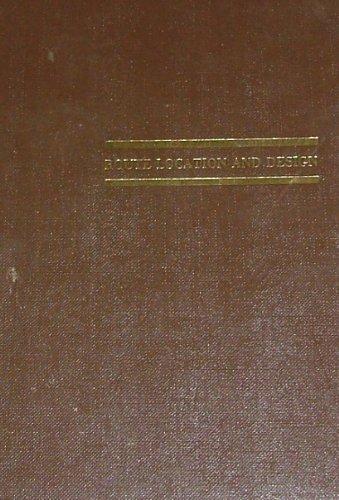Building Security: Handbook for Architectural Planning and Design
Barbara A. Nadel
"This book is a must-read for architects, landlords, security consultants and anyone else tasked with or interested in ensuring security and averting catastrophic loss."
— Bernard B. Kerik, 40th Police Commissioner, New York City (Ret.)
Whether planning for new construction, renovations, or security upgrades of existing facilities, Building Security: Handbook for Architectural Planning and Design is the definitive twenty-first century reference on security design, technology, building operations, and disaster planning. Award-winning architect and author Barbara A. Nadel, FAIA provides security design solutions for creating safe commercial, institutional, industrial, and residential buildings in the post-September 11, 2001, environment. Generously illustrated with 600 photos, drawings, tables, and checklists, this comprehensive compendium addresses protection from terrorism, natural disasters, chemical and biological agents, crime, and workplace violence, along with thorough, detailed coverage of:
* Lessons learned from benchmark events
* Planning and design of over 20 building types
* Historic preservation security guidelines
* Home and business disaster planning, response, and recovery
* Emergency management and facility procedures
* Protective structural design
* Mechanical, electrical, and fire protection design
* Chemical and biological protection
* Construction site emergency response guidelines
* Technology and security design
* Codes, standards, and security guidelines
* Liability exposure after September 11, 2001
This essential volume is the single-source reference for architects, engineers, planners, building owners, facility managers, construction and real estate professionals, public officials, safety specialists, educators, and students seeking to create safe, secure, and well-designed environments. Building Security: Handbook for Architectural Planning and Design received the 2003 Milka Bliznakov Prize Commendation from the International Archive of Women in Architecture.
Book Description:
* Illustrates how to assess and respond to threats from terrorism, natural disasters, emergencies, chemical and biological agents, crime, and workplace safety
* Provides one-stop reference on security planning, design, technology, building operations, disaster response, recovery, and crisis management
* Includes over 50 multidisciplinary contributors from over 30 professional firms, public agencies and nonprofit organizations across the United States
CONTRIBUTOR AFFILIATIONS
AMEC Construction Management Inc.
The Anti-Defamation League
Art Commission of the City of New York
Barbara Nadel Architect
Battelle Memorial Institute
DMJM
Flack + Kurtz Inc.
Fougeron Architecture
Harper Perkins Architects
HLW International LLP
HOK Sport + Venue +Event
International Association of Assembly Managers
KGA Architecture
National Crime Prevention Council
National Multi Housing Council
National Park Service
New York State Department of Correctional Services
New York State Department of Health
Oldcastle Glass
Planned Parenthood
RKK&G Museum & Cultural Facilities Consultants, Inc.
RTKL Associates, Inc.
Sako & Associates, Inc.
Skanska USA Building Inc
Skidmore, Owings & Merrill
Terrance J. Brown, FAIA
Thomas Blurock Architects
Thomas Phifer & Partners
The Thornton-Tomasetti Group Inc.
U.S. General Services Administration
Victor O. Schinnerer & Company, Inc.
Zetlin & De Chiara LLP
Barbara A. Nadel, FAIA, principal of Barbara Nadel Architect, specializes in planning and design of justice, healthcare, and institutional facilities. As an accomplished practitioner and journalist, Ms. Nadel's work on design, security, technology, and business has appeared in over 100 publications, including Architectural Record, Engineering News Record, and Time Saver Standards for Building Types. She has been interviewed and quoted in many publications and media outlets, including The New York Times, Fox News Channel, The Wall Street Journal, Newsday, La Libre Belgique, and others.
Well known in the architecture, design, and construction industry, Ms. Nadel was national 2001 Vice President of the American Institute of Architects, served twice on the national AIA Board of Directors, chaired the AIA Advertising Committee (responsible for creating a multimillion dollar print and radio advertising campaign), and chaired the AIA Committee on Architecture for Justice. She has received honor awards for outstanding leadership, service, and impact on the architectural profession.
Ms. Nadel is a graduate of the Rhode Island School of Design (Bachelor of Architecture, Bachelor of Fine Arts) and the State University of New York at Binghamton (Bachelor of Arts, Pre-Architecture). She has taught design and is a frequent guest lecturer and design award juror.
The Kentucky Post
Excerpts from article by Shelly Whitehead
A Farewell to Mayberry
Enhancing building security was top priority for new Boone facility
Kevlar walls. Blast windows. Blow rooms. In a post-9-11 world, designing secure buildings to protect and serve those sworn to protect and serve has gotten very complicated and costly. ….Security actually begins outside the building, where cameras record who enters what door and at what time, while a gated parking area ensures that only authorized employees' cars park in the walled lot adjoining the building. Such perimeter security considerations are primary in the minds of architects when designing critical infrastructure buildings like police departments.
"Every law enforcement agency is concerned about threats and being a target," said Barbara A. Nadel, a New York City-based fellow of the American Institute of Architects who this week publishes her voluminous reference book, "Building Security: Handbook for Architectural Planning and Design." "So if you go from the baseline that a police station is a target," she asked, "what do you do from there?" Ideally, she said, such buildings should have a setback from the road of 50 feet or more. "Then they have to take a look at access roads and -- how traffic and circulation goes toward a building."
..predicament for many law enforcement agencies struggling to build or renovate more secure quarters: They must create a facility which balances the need for a receptive, citizen-friendly environment with the
demand for a facility that is hardened against the violent and criminal forces that might stymie their efforts to protect and serve.
In fact, the predicament is so pervasive today Nadel said it's spawned a whole new architectural subheading called "transparent security." In essence, this means building safeguards into a structure through unobtrusive and sometimes invisible features.
"Everybody is concerned about this because they don't want to build fortresses. So what a lot of us are trying to do is to encourage transparent security. It is invisible to the public eye, but it's there," Nadel said.
"It's things like setbacks, laminated glass, blast windows. -- Then on the mechanical engineering side -- there are subtle things like moving air supply vents several stories higher -- where somebody can't throw some
substance into it and affect everybody inside."
As with Kentucky's police accreditation program, Nadel's book draws its recommendations for the future from the lessons learned through past tragedies, as interpreted by more than 50 multidisciplinary national experts. She says that, for all their collective horror, events like the 1995 Oklahoma City bombing and 2001 terrorist attacks spoke volumes to law enforcement
and other emergency responders about protecting themselves so that they might protect everyone else during mass tragedies. ...
| Name in long format: | Building Security: Handbook for Architectural Planning and Design |
|---|---|
| ISBN-10: | 0071411712 |
| ISBN-13: | 9780071411714 |
| Book pages: | 672 |
| Book language: | en |
| Edition: | 1 |
| Binding: | Hardcover |
| Publisher: | McGraw-Hill Education |
| Dimensions: | Height: 9.5 Inches, Length: 7.8 Inches, Weight: 2.83073544408 Pounds, Width: 1.44 Inches |














